 Greyhound racing, or dog racing as it is often generically referred to, is one of the oldest ‘sports’ there is. Racing itself goes back to 19th Century and Greyhounds were used long before this for coursing and hunting.
Greyhound racing, or dog racing as it is often generically referred to, is one of the oldest ‘sports’ there is. Racing itself goes back to 19th Century and Greyhounds were used long before this for coursing and hunting.
In post-war Europe dog racing was one of major pastimes for working class people, and indeed in the 1940’s there were over 70,000,000 people attending races in the UK alone. The fact that this was one of the only legitimate means of betting for normal people at the time also helped increase it’s popularity further.
In recent decades Greyhound racing has suffered with tracks continually closing and spectators choosing to spend their leisure time elsewhere. Punters too are choosing to spend their money wagering on other sports and events in a now open and free betting landscape.
Nevertheless Greyhound racing will continue to exist and will be around long into the future. Modern perspectives have however forced the industry to change dramatically in the face of increasing pressure to ensure the welfare of animals used for racing. Dogs are higher order animals and need to be treated with appropriate love and care.
This page you are about to read is written by a qualified Veterinarian who asks the question of what life is like for a modern Greyhound in racing. If you’ve ever wondered where Greyhounds come from, how they are bred, what traits they have, how they are cared for and how their welfare is ensured, then you will find it on this page.
Introduction To Greyhounds

The Greyhound is an extremely athletic and ancient breed belonging to the sighthound group of breeds. It was originally used for coursing and hunting and in recent centuries has become well known for its racing ability in the sport which we know as Greyhound racing.
Greyhound racing is legal in 8 countries around the world but much of the development of the modern racing Greyhound has taken place in Great Britain and Ireland, where at the height of its popularity in the 1940’s attendances at races reached over 70 million.
Greyhounds bred for racing are able to start their career at 15 months old in the UK and follow a structured lifestyle to try and optimise their racing capability. In Great Britain there are two different types of racing which take place called registered and independent racing. Registered or licensed racing is regulated by the Greyhound Board of Great Britain and generally follows higher standards than independent racing.
Despite this in recent years welfare issues concerning racing Greyhounds have come under the scrutiny of the public eye and the disappearance of a large number of retired dogs in addition to numerous doping scandals has given the sport a bad name.
In today’s world animal welfare and wellbeing is of utmost importance and a fair and clean sport has never been more important at a time when the popularity of the sport is in decline with numerous organisations opposing it. As with all animals it is essential that Greyhounds are well-treated, maintaining the highest standards of care if the sport is to have a future.
The life of a racing Greyhound and the way the breed has been developed as an elite athlete from its ancient origins is fascinating. Despite their early competitive careers most Greyhounds make excellent pets and can be successfully re-homed into a domestic environment, demonstrating the versatility of the breed.
Greyhound Racing Breeds and Breeders
 The Greyhound is an extremely old breed, and there is some debate about its exact origins.
The Greyhound is an extremely old breed, and there is some debate about its exact origins.
It was initially thought to have originated in the Middle East and this theory was backed up by evidence of dogs which resemble ancestors of the Greyhound found in Ancient Egyptian tombs where drawings dating back as far as 4000BC have been uncovered.
More recently genetic testing seems to indicate that the breed belongs to the Celtic group of breeds and its true origins may in fact be from Central and Eastern Europe later becoming popular in Spain, the British Isles and Ireland. The breed has fascinated all types of important figures ranging from artists to kings over thousands of years and is unique as it is the only breed of dog which is referred to in the bible.
There are different variations of the breed found around the world but the breed as we know it today has been largely influenced in more recent times by the way it was developed in Great Britain as a sporting breed initially used for hare coursing and hunting and then for track racing.
Breeding records of the modern Greyhound were first started in the 1700’s in private studbooks and in the 1800’s breeders in the United Kingdom started to use a public studbook.
Genetics and Health Problems

The Greyhound has a fairly broad genetic pool, owing to its use as a sporting breed, where functionality and good health are key, and this means they suffer from relatively few genetic conditions compared to some other breeds. This said in-breeding still occurs and can lead to the development of health problems, which are associated with the breed and are transmitted genetically such as Greyhound neuropathy and Greyhound meningoencephalitis.
Other conditions which seem to have a higher incidence in the Greyhound include hyperthermia and rigid paralysis after exercise, hypothyroidism, a predisposition to postoperative bleeding due to lower platelet numbers, cutaneous vasculopathy and congenital megaoesophagus.
Greyhounds are also especially sensitive to some anaesthetics and other medications, so care must be taken if a dog is to undergo any surgical procedures.
Breeding
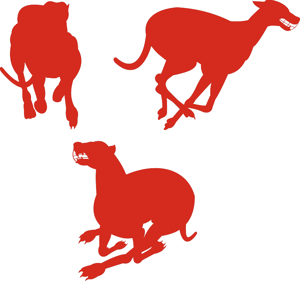 Breeding illegally and improperly can lead to health problems which represent a welfare concern but can also mean that registration in the breeds studbook is refused and this means limitations on the right to race at licensed tracks.
Breeding illegally and improperly can lead to health problems which represent a welfare concern but can also mean that registration in the breeds studbook is refused and this means limitations on the right to race at licensed tracks.
In the UK there are approximately 225 Greyhound breeding kennels with an additional 432 in Ireland. About 25,000 Greyhounds puppies are registered every year in the British Isles, although there a many more which are not registered. A top racing Greyhound can cost around £20,000, and in some cases, even more. Around 12,000 Greyhounds are registered every year in Great Britain as racing dogs.
Greyhound racing is legal in 8 countries around the world and the Greyhound is perhaps the breed which is best known for its athletic and racing abilities.
In other countries there are breeds such as the Saluki, Borzoi, Ibizan Hound, Afghan Hound and Scottish Deerhound which are also extremely fast, although these breeds were bred for hunting and coursing as opposed to track racing. Although they do not compete in the same way many of these breeds compete in trials, where their speed, agility and hunting ability are judged.
Greyhound Traits
 Greyhounds are a large and extremely athletic breed of dog which belongs to the sighthound group of breeds. They are sprinters and have the capacity to reach high speeds of up to 45 mph, and this has led to their use and refinement and development as a breed used for racing.
Greyhounds are a large and extremely athletic breed of dog which belongs to the sighthound group of breeds. They are sprinters and have the capacity to reach high speeds of up to 45 mph, and this has led to their use and refinement and development as a breed used for racing.
The breed is powerful and has a lean, muscular appearance with a deep chest which allows ample space for the heart and lungs. The Greyhound is a tall breed that should stand between 69 and 76 cm at the withers and weigh between 27 and 40 kg.
They have a long stride length and flexible spine which makes them excellent racing animals. In general male dogs are larger than females. The Greyhound has a smooth fine coat and comes in numerous different coat colours and colour combinations.
There are various countries around the world where the Greyhound is a popular breed for racing and coursing and it is used in a similar way to in the UK but there are some differences between the types of dogs selected in different countries. The type of Greyhound selected in the UK is often slightly larger than in many other countries where the breed is popular for racing.
The Greyhound is a sighthound and this means that they hunt using their keen sight as opposed to by scent. Humans have used this trait to create the breed as we know it today, selecting dogs which have the best sight and athletic capability combined with strong prey drive to chase things in order to train them to chase the lure which is used on racetracks today as a form of motivation.
Greyhound Board of Great Britain
 The Greyhound Board of Great Britain (GBGB) is the sole regulatory body responsible for monitoring and ensuring the smooth operation of licensed greyhound racing across Great Britain. The GBGB was established relatively recently in 2009, substituting and combining the functions and responsibilities of the British Greyhound Racing Board and the National Greyhound Racing Club.
The Greyhound Board of Great Britain (GBGB) is the sole regulatory body responsible for monitoring and ensuring the smooth operation of licensed greyhound racing across Great Britain. The GBGB was established relatively recently in 2009, substituting and combining the functions and responsibilities of the British Greyhound Racing Board and the National Greyhound Racing Club.
The GBGB’s principle purpose is to ensure the welfare of racing Greyhounds through their sporting careers whilst overseeing centres where racing takes place and the logistics of running races. The organisation is funded through a combination of annual licence fees from racecourses and attendees in addition to voluntary contributions made by bookmakers via the British Greyhound Racing Fund (BGRF).
The Board is strongly committed to reinforcing welfare standards, minimising injury rates, supporting retirement rules and re-homing programmes for ex-racing Greyhounds, reinforcing a fair and clean sport and supporting the professional development of those involved with the industry. More detailed information on the GBGBs commitments and values can be seen on their website.
Greyhound Racing Regulation in the UK

Greyhound racing is currently self-regulatory and this sometimes means that there are areas where welfare is lacking. In the UK there are regulations in place to protect animals in racing and to try to ensure the highest welfare standards possible.
In recent years The Welfare of Racing Greyhound Regulations from 2010 have been introduced and implemented, however, these regulations are focused mainly on welfare at the track and fail to address many other aspects of the Greyhounds life where welfare may be of concern during breeding, in kennels and retirement. In addition to these specific regulations all other animal welfare legislation also applies to Greyhounds.
Tracks where racing takes place must either be licensed by a local authority or run by an operator accredited by the United Kingdom Accreditation Service (UKAS), such as the GBGB. In order to be eligible to race on a GBGB regulated track British bred Greyhounds must be registered in the Greyhound Stud Book in the name of the owner.
Trainers must also be registered with the GBGB. This registration entitles them to be earmarked with a unique identification number which allows them to race. When registered in the Greyhound Stud Book or with the Irish Coursing Club a GBGB Registration Certificate can be obtained in addition to a vaccination or inoculation certificate which are both necessary for dogs to race at regulated tracks.
All Greyhounds should be fully vaccinated against parvovirus, distemper, viral hepatitis, leptospira canicola and leptospira icterihaemiorrhagiae.
These laws are principally enforced by the GBGB and consequences for breaking them include being removed from their register, fined and having to undergo a disciplinary committee hearing.
As a requirement for UKAS accreditation there is an impartiality committee which exists as an independent group providing advice to the GBGB and this consists of impartial experts who monitor the activities of the GBGB and its staff. Members of the public can place a complaint in confidence about Greyhound racing with the GBGB who will investigate further.
Independent vs Registered Racing
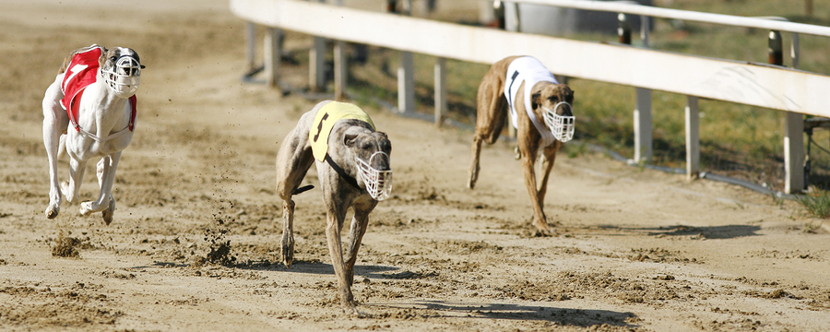
The GBGB is responsible for regulating licensed Greyhound racing, however not all Greyhound racing in Great Britain falls into this category. All licensed or registered racing must follow and comply with the rules and standards set out by the GBGB and takes place at 26 registered racecourses at the time of writing.
The other type of Greyhound racing which takes place in the UK is called independent racing or flapping and this type of racing is not governed by a central regulatory body. There are currently 5 racecourses where independent Greyhound racing takes place across Great Britain, and rules can vary between each venue. These are often referred to as Flapper tracks.
The GBGB has strict rules established for all aspects of the sport from registration through to retirement and breaking these rules can lead to bans and being reported to the police. This is why some owners and trainers choose to compete at independent venues where the way they operate is not as tightly restricted and controlled as at GBGB regulated venues.
Although independent or flapper tracks do not have to adhere to the same regulations and this allows potential for a failure to meet welfare standards, a low standard of care and a lack of responsibility towards the animal, it does not necessarily mean that welfare standards in all cases are low.
Many reputable trainers use these tracks at the beginning of a dogs racing career or owners who race for fun may choose to compete with their Greyhounds at these tracks. The lack of necessity for licensing and official paperwork to compete at these venues means it is a lot less costly. However, the lack of regulation and codes of welfare does mean that there is the potential for controversial practices to take place or failure to for minimum welfare standards to be met.
Flapper tracks are generally well-organised in a similar manner to licensed tracks to facilitate the commercial and spectator side of the sport. Some bookmakers do not offer the option to bet on races at these tracks and due to the lack of regulation those which do offer lower pay-out limits and odds.
Flapper tracks are often seen as dodgy and damaging to the image of the sport by those involved with licensed Greyhound racing and the hope is that at some point increased regulations will be enforced by the government restricting this type of racing.
Greyhound Racing Vets & Veterinary Inspections

At licensed racetracks there is always an attending veterinary surgeon who is a member of the Royal College of Veterinary Surgeons (RCVS) and is familiar with the duties and rules outlined by the GBGB.
Veterinary surgeons should always act in the dog’s best interest, to ensure welfare when it comes to providing treatment, but should have a comprehensive knowledge of racing rules and prohibited substances. This may create a conflict of interest between the intentions of the veterinarian with regards to necessary treatments and the ability of the dog to race.
Under GBGB rules all tracks should have a ‘veterinary treatment room’ which is appropriately equipped with all the necessary equipment and materials that may be needed if any treatments are required.
All dogs are identified and examined before the start of every race and the veterinarian looks to ensure the general health of racing dogs, their vaccination record and compliance with the necessary vaccinations and specified time periods, whether they are fit to compete, including whether they are suffering from any signs of cardiovascular or respiratory problems or lameness which could negatively impact the animal and evidence of any signs of doping which will affect the Greyhounds normal performance.
The veterinary surgeon can produce a certificate stating that a dog is unfit to run if in their opinion racing will be detrimental to the dog.
The veterinarian at a GBGB registered racetrack is entitled to proceed as they see fit in the case of an emergency or urgent treatment or surgery when it is the animal’s best interests, even without the permission of the owner. This can include euthanasia. In the case of injury the veterinary surgeon is responsible for recording the details of the injury the race or location in which it occurred and any treatments which were administered.
Other responsibilities of the official veterinary surgeon include:
- Certification of whether a bitch which has been in season is fit to run if less than 21 days have passed after the season.
- Control of contagious or infectious diseases on the premises.
- Veterinary supervision of international entries for open races.
- Establishing the cause of injury of a dog during a race, by watching replays of the race.
- Performing tests and analysis of samples taken from any Greyhound due to race when they deem fit.
- Taking samples if a dog dies suddenly, submitting them to an appropriate laboratory and organising for a post mortem examination to be performed.
- Authorising transportation of a sick animal.
Greyhound Welfare

Greyhound welfare has improved in recent years, as the sport has been the centre of lots of negative attention in the media which has forced changes to take place and the GBGB has worked hard to improve the image of the sport and promote welfare.
The introduction of the Welfare of Racing Greyhound Regulations 2010 was a major step forward to promoting high welfare standards at the racetrack, however there are still numerous aspects of the sport outside the track where there is a lack of regulation and in some cases poor welfare standards.
A major issue in the sport is what happens to dogs when they are retired, with large numbers reported as going missing after they are officially retired from racing. There has been a push towards rehoming Greyhounds and promoting them as excellent pets which has helped the situation but there is plenty of work still to do and the government is looking at introducing tighter regulations.
An improved system for following dogs throughout their life span and ensuring they are rehomed after retirement with heavier punishments for those who do not follow these rules will be key to putting an end to this situation and trying to limit irresponsible breeding.
Although many trainers maintain high standards at home the implementation of inspections at registered trainers and breeder’s facilities would also be a significant step to ensuring the adequate welfare of dogs throughout their racing lives. Despite the improvements which can be made the UK fares well in terms of the welfare of Greyhounds compared to in many other countries, with tougher penalties and legislation to punish those responsible for animal cruelty or malpractice.
It is much less likely for welfare issues at GBGB regulated racetracks to occur due to the extensive rules and procedures in place compared to independent tracks which are not governed by any official body and where rules vary between tracks.
There is a collective of people who are against the use of dogs in racing and believe the sport should be banned, claiming that the use of an animal with a dogs intelligence for racing cannot be justified and the sport is cruel. There are arguments for and against this point of view and opinion varies widely between individuals.
Anywhere where a large number of animals which travel around come together represents a risk for the spread of disease. Respiratory disease is a concern amongst racing Greyhounds as the stress of racing and transport in combination with contact with numerous other dogs can mean they are prone to being affected by kennel cough and canine haemorrhagic pneumonia, both of which are caused by respiratory pathogens.
Rules of Racing

The GBGB and all racecourses and trainers acting under this regulatory body must follow the ‘Rules of Racing’, which are stated in an extensive document covering all aspects of the sport and aim to ensure the welfare of racing Greyhounds under the most recent 2010 regulations in addition to ensuring a fair and clean sport.
The Rules of Racing includes procedures which must be followed if a dog is injured at a racecourse, recording the injury, circumstances and treatment administered and this information must be kept for 10 years after the event.
In particular there are clear specifications clarifying the conditions in which dogs should be kept at the racetrack; in individual kennels to prevent fighting between dogs where dogs are able to to lie down and constructed from materials which do not present any risks for injury, alongside other detailed points which should help to ensure welfare. In addition, an attending veterinarian must always be present, and inspections of the installations and materials used before each race must be performed at all regulated tracks.
The amount of time that racing dogs can spend in kennels before a race is stipulated and all dogs are weighed and examined by a veterinary surgeon prior to competing. After this examination dogs cannot be returned to kennels and must be kept in a secure location to try and minimise the risk of any tampering. If a delay is foreseen in the starting trap dogs should also be removed until the problem is resolved.
Greyhounds should always race wearing a muzzle, which complies with GBGB rules, this is light and allows proper breathing and ensures that there is no fighting between dogs, during or at the end of a race when dogs are still excited and is for their own protection.
The Life Of A Greyhound in Racing
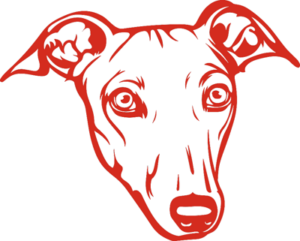 The life of a racing Greyhound may vary considerably depending on its owner and trainer. Most Greyhounds are weaned from their mother at around 8 weeks old and will stay with their littermates until they are about 5 months old when they are paired with another dog which they get on with well as a kennel mate. The following months are filled with training, how to walk on a lead, wear a muzzle and respond to voice commands as well as an introduction to chasing a lure.
The life of a racing Greyhound may vary considerably depending on its owner and trainer. Most Greyhounds are weaned from their mother at around 8 weeks old and will stay with their littermates until they are about 5 months old when they are paired with another dog which they get on with well as a kennel mate. The following months are filled with training, how to walk on a lead, wear a muzzle and respond to voice commands as well as an introduction to chasing a lure.
Proper race training usually starts at around a year old where they are introduced to different environments and learn how to race on a track. Most Greyhounds are kept in kennels with some form of soft bedding in an area to rest as well as possibly access to an outdoor run. The majority of well cared for Greyhounds are taken out and either exercised or allowed to run in a paddock several times a day.
There is an enormous range of approaches and some Greyhounds are cared for better than others. Kennels are generally disinfected daily, dogs are weighed and groomed and some may even be given massage, physiotherapy or hydrotherapy treatments depending on their needs. Diet differs enormously between kennels, but many trainers often feed their own preferred home-made diet, which often contains raw meats.
Racing career
Greyhounds are not allowed to race before 15 months of age in Great Britain and their career usually lasts until they are around 4 or 5 years old if they are not affected by injury.
As dogs mature and are successful or not they move up through different race categories and grades. Dogs are also grouped according to their age, sex and experience. Any races may be over hurdles or on the flat, over varying distances and around a varied number or bends.
In the UK the most common race distance is over 480 metres.
Open races
| Race category | Prize money | About |
|---|---|---|
| Derby | Minimum £50,000 | Six rounds to the competition overall. |
| Category 1 | Minimum £12,500 | 1-4 rounds to the competition to take place within 15 days. |
| Category 2 | Minimum £5,000 | 1, 2 or 3 rounds to take place within 15 days. |
| Category 3 | Minimum £1,000 | 1 or 2 rounds to take place within 9 days. |
| Invitation | Minimum £750 | Special race held by promoter where participants are invited to compete. |
| Minor | Minimum £150 | Any other open race. |
Graded races
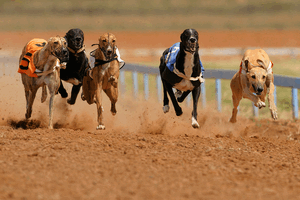 There are also graded races, which are any other races which do not fall into the above categories and represent a large number of the races held in the UK.
There are also graded races, which are any other races which do not fall into the above categories and represent a large number of the races held in the UK.
The Greyhounds are organised into groups or traps according to ability and grades from 1-11, where grade 1 is the highest level.
The letter preceding the grade number indicates what type of race it is:
- A: Standard races (with an average race distance of around 500m)
- D: Sprint races (with an average race distance of around 250m)
- S: Staying races (with an average race distance of around 650m)
- M: Marathon races (with an average race distance of around 850m)
- P: Puppy races
- H: Hurdle races
- Hcp: Handicap races
- B: This prefix indicates either a slightly shorter or longer standard race distance.
- V: Veteran races
The average Greyhound runs around once every 5-7 days and race distances vary between sprints of around 250m and marathons which can be as long as 1km. Different dogs are suited to different distances and the trainer will try and identify what type of distance is best suited to individual dogs.
Injuries, Fatalities, Success and Retirement
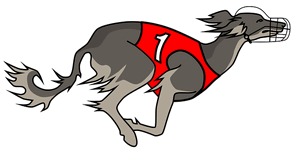 In 2017 the GBGB reported a total of 4,837 injuries which occurred while dogs were racing and 257 track fatalities.
In 2017 the GBGB reported a total of 4,837 injuries which occurred while dogs were racing and 257 track fatalities.
If a Greyhound suffers a career ending injury it should be retired and rehomed and this responsibility falls with the owner.
However, in some cases injuries may be so severe that dogs are put to sleep. A small number of dogs are designated unsuitable for rehoming due to temperament and these are also euthanised.
The difference in quality of life between a successful and an unsuccessful Greyhound can vary enormously. Inevitably a successful Greyhound will be treated with the utmost care and attention and this may perhaps mean on the whole it has a better quality of life than an unsuccessful dog, however this is not to say that there are many unsuccessful dogs which are not cared for equally well.
Buying and Selling Greyhounds
 Greyhounds are bought and sold in a number of ways. These include by identifying a trainer at a track where you want your dog to race and purchases between individuals, at an auction also known as a ‘Sales Trial’, where the highest bidder purchases the dog after it is put through a trial, testing its ability or by classified advertisements on the internet or in industry publications.
Greyhounds are bought and sold in a number of ways. These include by identifying a trainer at a track where you want your dog to race and purchases between individuals, at an auction also known as a ‘Sales Trial’, where the highest bidder purchases the dog after it is put through a trial, testing its ability or by classified advertisements on the internet or in industry publications.
Changing ownership does not necessarily have a negative impact on animals as a change in owner will not always mean a change in trainer or caregiver.
If there is a change in trainer or caregiver and this is not dealt with sensitively it has potential to negatively impact the dogs wellbeing, however if standards of care are high and the situation is dealt with appropriately there is no reason for this to always present a problem.
Inevitably most Greyhounds are probably closer to the people responsible for providing their day to day care, and in many cases, this is likely to be a trainer, or someone employed by a trainer, but this depends on the individual circumstances.
Anti-Doping in Greyhound Racing
 As with most competitive sport where money and high stakes are involved there has been a history of doping in Greyhound racing to try and improve on a dog’s natural performance ability.
As with most competitive sport where money and high stakes are involved there has been a history of doping in Greyhound racing to try and improve on a dog’s natural performance ability.
There are numerous substances such as sedatives, steroids and stimulants which are used but one of those to hit the headlines in recent times was dogs being given cocaine. The use of these types of substances allows owners and trainers the opportunity to control a dog’s performance on the track and gives them an advantage when it comes to gambling.
More recently scientific advances in detecting banned substances has made their use going undetected a lot more complicated and difficult to get away with, and this along with a crack-down on doping and a movement in the sport to portray it as clean and fair with high welfare standards in the public eye means that doping is less common than it has been in the past. This said not all tests are 100% reliable all the time and there are no doubt still cases where the use of banned substances still go undetected.
The sole responsibility to ensure that a Greyhound which is due to race has not been given any banned substances lies with the trainer. There are elective tests available for trainers to check for a number of prohibited substances available through the GBGB. The most common way of testing a dog for banned substances is by taking a urine sample and if this cannot be obtained a blood sample is taken by a veterinary surgeon.
Punishment for doping a Greyhound can range from a fine to a ban from racing at GBGB regulated tracks to time in jail and life bans on keeping dogs.
Greyhounds in Retirement
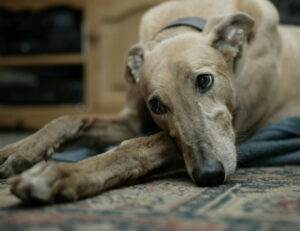 The end of the sporting career of a healthy Greyhound ends at a relatively young age at around 4 to 5 years old or perhaps earlier if a dog suffers from a career ending injury. This leaves plenty of years ahead for retirement and rehoming programmes for ex-racing dogs are therefore extremely important.
The end of the sporting career of a healthy Greyhound ends at a relatively young age at around 4 to 5 years old or perhaps earlier if a dog suffers from a career ending injury. This leaves plenty of years ahead for retirement and rehoming programmes for ex-racing dogs are therefore extremely important.
Greyhounds make excellent pets and are generally gentle, affectionate and clever with an easy-going temperament. Contrary to the common misconception that Greyhounds need a lot of exercise they in fact need relatively little walking and a couple of 20 minute walks a day are usually sufficient.
The breed is usually docile and well-mannered. Greyhounds are normally good around people and get on well with all members of the family, including children as well as often happily living alongside other pets such as cats, although this varies between individual dogs.
At first, care should be taken when Greyhounds are out on walks as their instinct to chase things can be extremely strong and this combined with their race training can mean that they are prone to chasing small animals, although the strength of this prey drive varies widely between individuals.
When considering whether rehoming a Greyhound could be the right choice for you it is important, as with any other dog, to weigh up whether you can make the long-term, every day commitment that owning a dog involves. No dog should be left home alone with no outdoor access for prolonged periods of time. Owning any pet is a responsibility and a Greyhound can easily live until around 10-12 years old, and often longer.
Their instinct to chase things means that at first it is advisable to walk them on the lead and with a muzzle until you get to know their individual character. Although they do not need a lot of walking and can happily live in an urban environment it is also important to remember that Greyhounds are fairly large dogs and therefore not suitable if you live in a small flat or apartment.
Owners are responsible for rehoming their retired Greyhounds and there are numerous charities which help facilitate the rehoming of ex-racing Greyhounds, including many dog rehoming centres. One of the largest and most well-known organisations dedicated solely to the rehoming of Greyhounds is the Greyhound Trust which is experienced at rehoming the breed and matching appropriate dogs depending on your home situation and life-style.
In recent years there have been numerous stories in the press and cases of ex racing Greyhounds going ‘missing’ in retirement. Unfortunately, these cases give the industry and sport a bad name and the poor practice of a minority tars the owners, trainers and organisations who do their best to rehome retired dogs a bad name.
There are no doubt cases where dogs have disappeared due to the inconvenience of rehoming them in retirement but the industry as a whole is trying to move towards better practice when it comes to ensuring a long happy life for ex racing dogs.
Other lives which may follow racing for retired dogs include for breeding if their racing career has been successful, for coursing, modern dog sports such as flyball, showing, therapy dogs and as companion and family pets.
About The Author

The author is a qualified veterinary surgeon and member of the Royal College of Veterinary Surgeons with a Masters degree in Equine Reproduction and is currently undertaking a PhD.
She has a keen interest in sports medicine, animal nutrition and has been involved in numerous veterinary education projects and initiatives, with a strong belief that access to good quality information is vital to improving the welfare of animals.